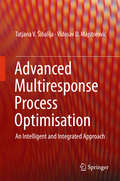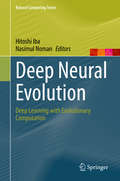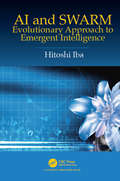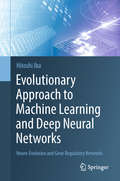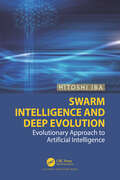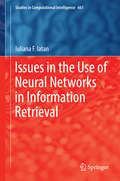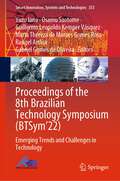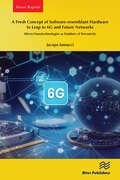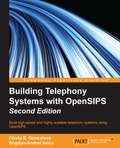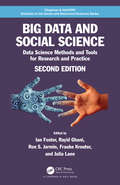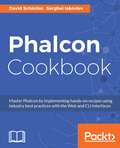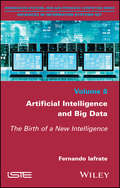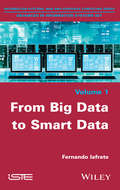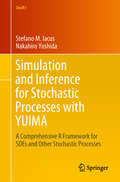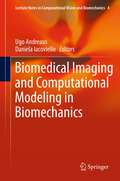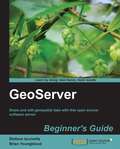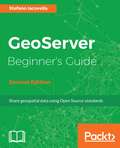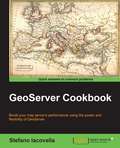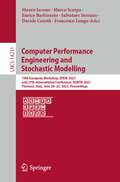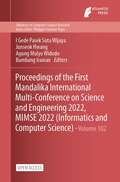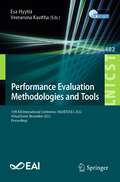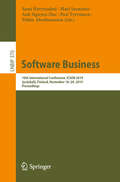- Table View
- List View
Advanced Multiresponse Process Optimisation: An Intelligent and Integrated Approach
by Tatjana V. Šibalija Vidosav D. MajstorovićThis book presents an intelligent, integrated, problem-independent method for multiresponse process optimization. In contrast to traditional approaches, the idea of this method is to provide a unique model for the optimization of various processes, without imposition of assumptions relating to the type of process, the type and number of process parameters and responses, or interdependences among them. The presented method for experimental design of processes with multiple correlated responses is composed of three modules: an expert system that selects the experimental plan based on the orthogonal arrays; the factor effects approach, which performs processing of experimental data based on Taguchi's quality loss function and multivariate statistical methods; and process modeling and optimization based on artificial neural networks and metaheuristic optimization algorithms. The implementation is demonstrated using four case studies relating to high-tech industries and advanced, non-conventional processes.
Deep Neural Evolution: Deep Learning with Evolutionary Computation (Natural Computing Series)
by Hitoshi Iba Nasimul NomanThis book delivers the state of the art in deep learning (DL) methods hybridized with evolutionary computation (EC). Over the last decade, DL has dramatically reformed many domains: computer vision, speech recognition, healthcare, and automatic game playing, to mention only a few. All DL models, using different architectures and algorithms, utilize multiple processing layers for extracting a hierarchy of abstractions of data. Their remarkable successes notwithstanding, these powerful models are facing many challenges, and this book presents the collaborative efforts by researchers in EC to solve some of the problems in DL. EC comprises optimization techniques that are useful when problems are complex or poorly understood, or insufficient information about the problem domain is available. This family of algorithms has proven effective in solving problems with challenging characteristics such as non-convexity, non-linearity, noise, and irregularity, which dampen the performance of most classic optimization schemes. Furthermore, EC has been extensively and successfully applied in artificial neural network (ANN) research —from parameter estimation to structure optimization. Consequently, EC researchers are enthusiastic about applying their arsenal for the design and optimization of deep neural networks (DNN). This book brings together the recent progress in DL research where the focus is particularly on three sub-domains that integrate EC with DL: (1) EC for hyper-parameter optimization in DNN; (2) EC for DNN architecture design; and (3) Deep neuroevolution. The book also presents interesting applications of DL with EC in real-world problems, e.g., malware classification and object detection. Additionally, it covers recent applications of EC in DL, e.g. generative adversarial networks (GAN) training and adversarial attacks. The book aims to prompt and facilitate the research in DL with EC both in theory and in practice.
AI and SWARM: Evolutionary Approach to Emergent Intelligence
by Hitoshi IbaThis book provides theoretical and practical knowledge on AI and swarm intelligence. It provides a methodology for EA (evolutionary algorithm)-based approach for complex adaptive systems with the integration of several meta-heuristics, e.g., ACO (Ant Colony Optimization), ABC (Artificial Bee Colony), and PSO (Particle Swarm Optimization), etc. These developments contribute towards better problem-solving methodologies in AI. The book also covers emerging uses of swarm intelligence in applications such as complex adaptive systems, reaction-diffusion computing, and diffusion-limited aggregation, etc. Another emphasis is its real-world applications. We give empirical examples from real-world problems and show that the proposed approaches are successful when addressing tasks from such areas as swarm robotics, silicon traffics, image understanding, Vornoi diagrams, queuing theory, and slime intelligence, etc. Each chapter begins with the background of the problem followed by the current state-of-the-art techniques of the field, and ends with a detailed discussion. In addition, the simulators, based on optimizers such as PSO and ABC complex adaptive system simulation, are described in detail. These simulators, as well as some source codes, are available online on the author’s website for the benefit of readers interested in getting some hands-on experience of the subject. The concepts presented in this book aim to promote and facilitate the effective research in swarm intelligence approaches in both theory and practice. This book would also be of value to other readers because it covers interdisciplinary research topics that encompass problem-solving tasks in AI, complex adaptive systems, and meta-heuristics.
Evolutionary Approach to Machine Learning and Deep Neural Networks: Neuro-Evolution and Gene Regulatory Networks
by Hitoshi IbaThis book provides theoretical and practical knowledge about a methodology for evolutionary algorithm-based search strategy with the integration of several machine learning and deep learning techniques. These include convolutional neural networks, Gröbner bases, relevance vector machines, transfer learning, bagging and boosting methods, clustering techniques (affinity propagation), and belief networks, among others. The development of such tools contributes to better optimizing methodologies. Beginning with the essentials of evolutionary algorithms and covering interdisciplinary research topics, the contents of this book are valuable for different classes of readers: novice, intermediate, and also expert readers from related fields.Following the chapters on introduction and basic methods, Chapter 3 details a new research direction, i.e., neuro-evolution, an evolutionary method for the generation of deep neural networks, and also describes how evolutionary methods are extended in combination with machine learning techniques. Chapter 4 includes novel methods such as particle swarm optimization based on affinity propagation (PSOAP), and transfer learning for differential evolution (TRADE), another machine learning approach for extending differential evolution. The last chapter is dedicated to the state of the art in gene regulatory network (GRN) research as one of the most interesting and active research fields. The author describes an evolving reaction network, which expands the neuro-evolution methodology to produce a type of genetic network suitable for biochemical systems and has succeeded in designing genetic circuits in synthetic biology. The author also presents real-world GRN application to several artificial intelligent tasks, proposing a framework of motion generation by GRNs (MONGERN), which evolves GRNs to operate a real humanoid robot.
Swarm Intelligence and Deep Evolution: Evolutionary Approach to Artificial Intelligence
by Hitoshi IbaThe book provides theoretical and practical knowledge about swarm intelligence and evolutionary computation. It describes the emerging trends in deep learning that involve the integration of swarm intelligence and evolutionary computation with deep learning, i.e., deep neuroevolution and deep swarms. The study reviews the research on network structures and hyperparameters in deep learning, and attracting attention as a new trend in AI. A part of the coverage of the book is based on the results of practical examples as well as various real-world applications. The future of AI, based on the ideas of swarm intelligence and evolution is also covered. The book is an introductory work for researchers. Approaches to the realization of AI and the emergence of intelligence are explained, with emphasis on evolution and learning. It is designed for beginners who do not have any knowledge of algorithms or biology, and explains the basics of neural networks and deep learning in an easy-to-understand manner. As a practical exercise in neuroevolution, the book shows how to learn to drive a racing car and a helicopter using MindRender. MindRender is an AI educational software that allows the readers to create and play with VR programs, and provides a variety of examples so that the readers will be able to create and understand AI.
Issues in the Use of Neural Networks in Information Retrieval
by Iuliana F. IatanThis book highlights the ability of neural networks (NNs) to be excellent pattern matchers and their importance in information retrieval (IR), which is based on index term matching. The book defines a new NN-based method for learning image similarity and describes how to use fuzzy Gaussian neural networks to predict personality. It introduces the fuzzy Clifford Gaussian network, and two concurrent neural models: (1) concurrent fuzzy nonlinear perceptron modules, and (2) concurrent fuzzy Gaussian neural network modules. Furthermore, it explains the design of a new model of fuzzy nonlinear perceptron based on alpha level sets and describes a recurrent fuzzy neural network model with a learning algorithm based on the improved particle swarm optimization method.
Proceedings of the 8th Brazilian Technology Symposium: Emerging Trends and Challenges in Technology (Smart Innovation, Systems and Technologies #353)
by Yuzo Iano Osamu Saotome Guillermo Leopoldo Kemper Vásquez Maria Thereza de Moraes Gomes Rosa Rangel Arthur Gabriel Gomes de OliveiraThis book presents the proceedings of the 8th Brazilian Technology Symposium (BTSym'22). The book discusses current technological issues on Systems Engineering, Mathematics, and Physical Sciences, such as the Transmission Line, Protein-Modified Mortars, Electromagnetic Properties, Clock Domains, Chebyshev Polynomials, Satellite Control Systems, Hough Transform, Watershed Transform, Blood Smear Images, Toxoplasma Gondi, Operation System Developments, MIMO Systems, Geothermal-Photovoltaic Energy Systems, Mineral Flotation Application, CMOS Techniques, Frameworks Developments, Physiological Parameters Applications, Brain–Computer Interface, Artificial Neural Networks, Computational Vision, Security Applications, FPGA Applications, IoT, Residential Automation, Data Acquisition, Industry 4.0, Cyber-Physical Systems, Digital Image Processing, Patters Recognition, Machine Learning, Photocatalytic Process, Physical-Chemical Analysis, Smoothing Filters, Frequency Synthesizers, Voltage Controlled Ring Oscillator, Difference Amplifier, Photocatalysis, and Photodegradation, and current technological issues on Human, Smart, and Sustainable Future of Cities, such as the Digital Transformation, Data Science, Hydrothermal Dispatch, Project Knowledge Transfer, Immunization Programs, Efficiency and Predictive Methods, PMBOK Applications, Logistics Process, IoT, Data Acquisition, Industry 4.0, Cyber-Physical Systems, Fingerspelling Recognition, Cognitive Ergonomics, Ecosystem Services, Environmental, Ecosystem Services valuation, Solid Waste, and University Extension.
The Audacity Of Hype: Bewilderment, sleaze and other tales of the 21st century
by Armando IannucciIn THE AUDACITY OF HYPE, Armando Iannucci cuts straight to the heart of the insanity and sherbet-headed nonsense of modern life. THE AUDACITY OF HYPE brings together his views on diverse subjects, ranging from wickedly funny pen portraits of the sometimes loveable, usually despicable chumps who like to think of themselves as our political elite, and their bonkers schemes to save the world that are in fact likely to do us more harm than a pile of witches, to WMD, disaster movies, the pitfalls of 'I'm A Celebrity, Get Me Out Of Here' and the high and mighty rhetoric of Obama, this is an absurdly entertaining and utterly indispensable collection from one of Britain's most brilliant satirists.
The Audacity Of Hype: Bewilderment, sleaze and other tales of the 21st century
by Armando IannucciIn THE AUDACITY OF HYPE, Armando Iannucci cuts straight to the heart of the insanity and sherbet-headed nonsense of modern life. THE AUDACITY OF HYPE brings together his views on diverse subjects, ranging from wickedly funny pen portraits of the sometimes loveable, usually despicable chumps who like to think of themselves as our political elite, and their bonkers schemes to save the world that are in fact likely to do us more harm than a pile of witches, to WMD, disaster movies, the pitfalls of 'I'm A Celebrity, Get Me Out Of Here' and the high and mighty rhetoric of Obama, this is an absurdly entertaining and utterly indispensable collection from one of Britain's most brilliant satirists.
A Fresh Concept of Software-resemblant Hardware to Leap to 6G and Future Networks: Micro/Nanotechnologies as Enablers of Pervasivity
by Jacopo IannacciFor a decade, with the uptake of 4G, we have become accustomed to the relentless increase in data and services on the move. The deployment of 5G is advancing crucial key performance indicators (KPIs), along with quality of service (QoS). Setting the horizon to 2030 and later, 6G will take the KPIs to numbers 100–1000 times better than 5G. Yet, the actual disruption of 6G and future networks (FN) will take place following other unprecedented paths.Artificial intelligence (AI) will be exploited in a threadlike fashion, at any level of the network physical infrastructure. This will introduce, to date unknown features, like self-sustaining, self-evolution and high-resilience of small portions of the infrastructure, pioneering the concept of a network of networks. Each segment of the infrastructure will bear a high degree of independence, while working at the same time as a whole, in full orchestration with the rest of the network.Given such a scenario, this book claims that the established and currently in use paradigms for the design and development of hardware–software (HW–SW) systems, are not appropriate to address the challenges of 6G and, further ahead, of FN. In response, unprecedented design approaches are suggested, relying on a fresh reinterpretation of the standard concept of HW, with specific attention to the network edge and edge intelligence (EI).This work develops some conceptual tools that may help address the technical challenges resulting from the intricate scenario sketched above. Within the mentioned HW reconceptualization, a pivotal role is forecasted for microtechnologies and nanotechnologies, intended with a broad meaning, which embraces, among others, devices, systems (MEMS/NEMS) and materials.
Building Telephony Systems with OpenSIPS - Second Edition
by Bogdan-Andrei Iancu Flavio E. GoncalvesBuild high-speed and highly scalable telephony systems using OpenSIPS About This Book * Install and configure OpenSIPS to authenticate, route, bill, and monitor VoIP calls * Gain a competitive edge using the most scalable VoIP technology * Discover the latest features of OpenSIPS with practical examples and case studies Who This Book Is For If you want to understand how to build a SIP provider from scratch using OpenSIPS, then this book is ideal for you. It is beneficial for VoIP providers, large enterprises, and universities. This book will also help readers who were using OpenSER but are now confused with the new OpenSIPS. Telephony and Linux experience will be helpful to get the most out of this book but is not essential. Prior knowledge of OpenSIPS is not assumed. What You Will Learn * Learn to prepare and configure a Linux system for OpenSIPS * Familiarise yourself with the installation and configuration of OpenSIPS * Understand how to set a domain and create users/extensions * Configure SIP endpoints and make calls between them * Make calls to and from the PSTN and create access control lists to authorize calls * Install a graphical user interface to simplify the task of provisioning user and system information * Implement an effective billing system with OpenSIPS * Monitor and troubleshoot OpenSIPS to keep it running smoothly In Detail OpenSIPS is a multifunctional, multipurpose signalling SIP server. SIP (Session Initiation Protocol) is nowadays the most important VoIP protocol and OpenSIPS is the open source leader in VoIP platforms based on SIP. OpenSIPS is used to set up SIP Proxy servers. The purpose of these servers is to receive, examine, and classify SIP requests. The whole telecommunication industry is changing to an IP environment, and telephony as we know it today will completely change in less than ten years. SIP is the protocol leading this disruptive revolution and it is one of the main protocols on next generation networks. While a VoIP provider is not the only kind of SIP infrastructure created using OpenSIPS, it is certainly one of the most difficult to implement. This book will give you a competitive edge by helping you to create a SIP infrastructure capable of handling tens of thousands of subscribers. Starting with an introduction to SIP and OpenSIPS, you will begin by installing and configuring OpenSIPS. You will be introduced to OpenSIPS Scripting language and OpenSIPS Routing concepts, followed by comprehensive coverage of Subscriber Management. Next, you will learn to install, configure, and customize the OpenSIPS control panel and explore dialplans and routing. You will discover how to manage the dialog module, accounting, NATTraversal, and other new SIP services. The final chapters of the book are dedicated to troubleshooting tools, SIP security, and advanced scenarios including TCP/TLS support, load balancing, asynchronous processing, and more. A fictional VoIP provider is used to explain OpenSIPS and by the end of the book, you will have a simple but complete system to run a VoIP provider. Style and approach This book is a step-by-step guide based on the example of a VoIP provider. You will start with OpenSIPS installation and gradually, your knowledge depth will increase.
Big Data and Social Science: Data Science Methods and Tools for Research and Practice (Chapman & Hall/CRC Statistics in the Social and Behavioral Sciences)
by Ian Foster, Rayid Ghani, Ron S. Jarmin, Frauke Kreuter and Julia LaneBig Data and Social Science: Data Science Methods and Tools for Research and Practice, Second Edition shows how to apply data science to real-world problems, covering all stages of a data-intensive social science or policy project. Prominent leaders in the social sciences, statistics, and computer science as well as the field of data science provide a unique perspective on how to apply modern social science research principles and current analytical and computational tools. The text teaches you how to identify and collect appropriate data, apply data science methods and tools to the data, and recognize and respond to data errors, biases, and limitations. Features: Takes an accessible, hands-on approach to handling new types of data in the social sciences Presents the key data science tools in a non-intimidating way to both social and data scientists while keeping the focus on research questions and purposes Illustrates social science and data science principles through real-world problems Links computer science concepts to practical social science research Promotes good scientific practice Provides freely available workbooks with data, code, and practical programming exercises, through Binder and GitHub New to the Second Edition: Increased use of examples from different areas of social sciences New chapter on dealing with Bias and Fairness in Machine Learning models Expanded chapters focusing on Machine Learning and Text Analysis Revamped hands-on Jupyter notebooks to reinforce concepts covered in each chapter This classroom-tested book fills a major gap in graduate- and professional-level data science and social science education. It can be used to train a new generation of social data scientists to tackle real-world problems and improve the skills and competencies of applied social scientists and public policy practitioners. It empowers you to use the massive and rapidly growing amounts of available data to interpret economic and social activities in a scientific and rigorous manner.
Phalcon Cookbook
by Serghei Iakovlev David SchisslerMaster Phalcon by implementing hands-on recipes using industry best practices with the Web and CLI interfaces About This Book * Create quick prototypes with the Phalcon Developer Tools * Learn to use the powerful and uniquely efficient Phalcon ORM * Reuse codes in real projects Who This Book Is For If you are a beginner-to-intermediate Phalcon developer who wants to level up or an advanced user who is seeking some new techniques and insight, then this book is perfect for you. This book will be relevant to you over a long period of time due to the mixed nature of this book in providing both abstract comprehension as well as specific examples meant to be usable in your projects. You will be able to experiment with each new aspect of integration in prebuilt recipes meant to best illustrate each specific feature. This will save you lots of time getting up to speed before attempting to integrate into a real application. What You Will Learn * Install the Phalcon extension from both premade packages and source code * Create a normal and micro application structure * Understand the dispatcher event cycle and create custom plugins * Get hands-on using the Phalcon Query Language and ORM * Create flexible views with the Volt template system * Leverage Phalcon to prevent common security vulnerabilities * Optimize an application with focused solutions * Profile and debug an application to get increased reliability In Detail Phalcon is a high-performance PHP framework delivered as a PHP extension. This provides new opportunities for speed and application design, which until recently have been unrealized in the PHP ecosystem. Packed with simple learning exercises, technology prototypes, and real-world usable code, this book will guide you from the beginner and setup stage all the way to advanced usage. You will learn how to avoid niche pitfalls, how to use the command-line developer tools, how to integrate with new web standards, as well as how to set up and customize the MVC application structure. You will see how Phalcon can be used to quickly set up a single file web application as well as a complex multi-module application suitable for long-term projects. Some of the recipes focus on abstract concepts that are vital to get a deep comprehension of Phalcon and others are designed as a vehicle to deliver real-world usable classes and code snippets to solve advanced problems. You'll start out with basic setup and application structure and then move onto the Phalcon MVC and routing implementation, the power of the ORM and Phalcon Query Language, and Phalcon's own Volt templating system. Finally, you will move on to caching, security, and optimization. Style and approach An easy-to-start guide that provides
Artificial Intelligence and Big Data: The Birth of a New Intelligence
by Fernando IafrateWith the idea of “deep learning” having now become the key to this new generation of solutions, major technological players in the business intelligence sector have taken an interest in the application of Big Data. In this book, the author explores the recent technological advances associated with digitized data flows, which have recently opened up new horizons for AI. The reader will gain insight into some of the areas of application of Big Data in AI, including robotics, home automation, health, security, image recognition and natural language processing.
From Big Data to Smart Data
by Fernando IafrateA pragmatic approach to Big Data by taking the reader on a journey between Big Data (what it is) and the Smart Data (what it is for). Today's decision making can be reached via information (related to the data), knowledge (related to people and processes), and timing (the capacity to decide, act and react at the right time). The huge increase in volume of data traffic, and its format (unstructured data such as blogs, logs, and video) generated by the "digitalization" of our world modifies radically our relationship to the space (in motion) and time, dimension and by capillarity, the enterprise vision of performance monitoring and optimization.
From Big Data to Smart Data
by Fernando IafrateA pragmatic approach to Big Data by taking the reader on a journey between Big Data (what it is) and the Smart Data (what it is for). Today’s decision making can be reached via information (related to the data), knowledge (related to people and processes), and timing (the capacity to decide, act and react at the right time). The huge increase in volume of data traffic, and its format (unstructured data such as blogs, logs, and video) generated by the “digitalization” of our world modifies radically our relationship to the space (in motion) and time, dimension and by capillarity, the enterprise vision of performance monitoring and optimization.
Simulation and Inference for Stochastic Processes with YUIMA: A Comprehensive R Framework for SDEs and Other Stochastic Processes (Use R!)
by Stefano M. Iacus Nakahiro YoshidaThe YUIMA package is the first comprehensive R framework based on S4 classes and methods which allows for the simulation of stochastic differential equations driven by Wiener process, Lévy processes or fractional Brownian motion, as well as CARMA, COGARCH, and Point processes. The package performs various central statistical analyses such as quasi maximum likelihood estimation, adaptive Bayes estimation, structural change point analysis, hypotheses testing, asynchronous covariance estimation, lead-lag estimation, LASSO model selection, and so on. YUIMA also supports stochastic numerical analysis by fast computation of the expected value of functionals of stochastic processes through automatic asymptotic expansion by means of the Malliavin calculus. All models can be multidimensional, multiparametric or non parametric.The book explains briefly the underlying theory for simulation and inference of several classes of stochastic processes and then presents both simulation experiments and applications to real data. Although these processes have been originally proposed in physics and more recently in finance, they are becoming popular also in biology due to the fact the time course experimental data are now available. The YUIMA package, available on CRAN, can be freely downloaded and this companion book will make the user able to start his or her analysis from the first page.
Biomedical Imaging and Computational Modeling in Biomechanics (Lecture Notes in Computational Vision and Biomechanics #4)
by Daniela Iacoviello Ugo AndreausThis book collects the state-of-art and new trends in image analysis and biomechanics. It covers a wide field of scientific and cultural topics, ranging from remodeling of bone tissue under the mechanical stimulus up to optimizing the performance of sports equipment, through the patient-specific modeling in orthopedics, microtomography and its application in oral and implant research, computational modeling in the field of hip prostheses, image based model development and analysis of the human knee joint, kinematics of the hip joint, micro-scale analysis of compositional and mechanical properties of dentin, automated techniques for cervical cell image analysis, and biomedical imaging and computational modeling in cardiovascular disease. The book will be of interest to researchers, Ph.D students, and graduate students with multidisciplinary interests related to image analysis and understanding, medical imaging, biomechanics, simulation and modeling, experimental analysis
GeoServer Beginner’s Guide
by Stefano Iacovella Brian YoungbloodStep-by-step instructions are included and the needs of a beginner are totally satisfied by the book. The book consists of plenty of examples with accompanying screenshots and code for an easy learning curve. You are a web developer with knowledge of server side scripting, and have experience with installing applications on the server. You have a desire to want more than Google maps, by offering dynamically built maps on your site with your latest geospatial data stored in MySQL, PostGIS, MsSQL or Oracle. If this is the case, this book is meant for you.
GeoServer Beginner's Guide - Second Edition
by Stefano IacovellaThis step-by-step guide will teach you how to use GeoServer to build custom and interactive maps using your data. About This Book • Exploit the power of GeoServer to provide agile, flexible, and low -cost community projects • Share real-time maps quickly • Boost your map server's performance using the power and flexibility of GeoServer Who This Book Is For If you are a web developer with knowledge of server side scripting, have experience in installing applications on the server, and want to go beyond Google Maps by offering dynamically built maps on your site with your latest geospatial data stored in MySQL, PostGIS, MySQL, or Oracle, this is the book for you. What You Will Learn • Install GeoServer quickly • Access dynamic real-time geospatial data that you can easily integrate into your own web-based application • Create custom styles for lines, points, and polygons for great-looking maps • Command GeoServer remotely using REST • Tune your GeoServer instance for performance • Move GeoServer into production • Learn advanced topics to extend GeoServer's capabilities In Detail GeoServer is an opensource server written in Java that allows users to share, process, and edit geospatial data. This book will guide you through the new features and improvements of GeoServer and will help you get started with it. GeoServer Beginner's Guide gives you the impetus to build custom maps using your data without the need for costly commercial software licenses and restrictions. Even if you do not have prior GIS knowledge, you will be able to make interactive maps after reading this book. You will install GeoServer, access your data from a database, and apply style points, lines, polygons, and labels to impress site visitors with real-time maps. Then you follow a step-by-step guide that installs GeoServer in minutes. You will explore the web-based administrative interface to connect to backend data stores such as PostGIS, and Oracle. Going ahead, you can display your data on web-based interactive maps, use style lines, points, polygons, and embed images to visualize this data for your web visitors. You will walk away from this book with a working application ready for production. After reading GeoServer Beginner's Guide, you will be able to build beautiful custom maps on your website using your geospatial data. Style and approach Step-by-step instructions are included and the needs of a beginner are totally satisfied by the book. The book consists of plenty of examples with accompanying screenshots and code for an easy learning curve.
GeoServer Cookbook
by Stefano IacovellaThis book is ideal for GIS experts, developers, and system administrators who have had a first glance at GeoServer and who are eager to explore all its features in order to configure professional map servers. Basic knowledge of GIS and GeoServer is required.
Computer Performance Engineering and Stochastic Modelling: 19th European Workshop, EPEW 2023, and 27th International Conference, ASMTA 2023, Florence, Italy, June 20–23, 2023, Proceedings (Lecture Notes in Computer Science #14231)
by Mauro Iacono Marco Scarpa Enrico Barbierato Salvatore Serrano Davide Cerotti Francesco LongoThis book constitutes the refereed proceedings of the 19th European Workshop on Computer Performance Engineering, EPEW 2023, and 27th International Conference on Analytical and Stochastic Modelling Techniques and Applications, ASMTA 2023, held in Florence, Italy, in June 2023.The 26 papers presented in this volume were carefully reviewed and selected from 35 submissions. The papers presented at the workshop reflect the diversity of modern performance engineering. The sessions covered a wide range of topics including robustness analysis, machine learning, edge and cloud computing, as well as more traditional topics on stochastic modelling, techniques and tools.
Proceedings of the First Mandalika International Multi-Conference on Science and Engineering 2022, MIMSE 2022 (Advances in Computer Science Research #102)
by I Gede Pasek Suta Wijaya Junseok Hwang Agung Mulyo Widodo Bambang IrawanThis is an open access book. The covid-19 pandemic today forces humans to do almost all activities from home. Consequently, inventions in many fields of engineering technology are needed to facilitate those activities. First, human activities mainly are based on information technology today and internet connection is very important. People generate, send, and receive data by their smartphones every time and everything is connected to the internet. Equipment becomes smarter to assist the owner. Second, People need powerful, efficient, and smart vehicles and machines in Industry 4.0. Third, the need for energy increases, which causes the decrease of global environmental quality. It needs new technology for saving energy by discovering new technologies in mechanical engineering. Fourth, many technologies emerge as disaster prevention by developing innovations in civil engineering and architecture.The Engineering Faculty of University of Mataram invites engineers and researchers around the world to visit Lombok island and to attend the valuable multi fields conference on science and engineering named “The First Mandalika International Multi-conference on Science and Engineering 2022″ or “1st MIMSE 2022”. This fruitful event will be the annual conference in Lombok island which is supported by the West Nusa Tenggara Province government. Initially, the 1st MIMSE 2022 consisted of 5 engineering fields are Civil, Architecture, Electrical, Mechanical, and Informatics Engineering.
Performance Evaluation Methodologies and Tools: 15th EAI International Conference, VALUETOOLS 2022, Virtual Event, November 2022, Proceedings (Lecture Notes of the Institute for Computer Sciences, Social Informatics and Telecommunications Engineering #482)
by Esa Hyytiä Veeraruna KavithaThis book constitutes the refereed conference proceedings of the 15th International Conference on Performance Evaluation Methodologies and Tools, VALUETOOLS 2022, held in November 2022. Due to the safety concerns and travel restrictions caused by COVID-19, VALUETOOLS 2022 took place online in a live stream. The conference provides a world-leading and multidisciplinary venue for researchers and practitioners in diverse disciplines such as computer science, networks and telecommunications, operations research, optimization, control theory and manufacturing. The 18 full papers were carefully reviewed and selected from 47 submissions and are grouped in thematically as following: game theory; queueing models; applications; retrial queues; performance analysis and networking; distributed computing.
Software Business: 10th International Conference, ICSOB 2019, Jyväskylä, Finland, November 18–20, 2019, Proceedings (Lecture Notes in Business Information Processing #370)
by Sami Hyrynsalmi Mari Suoranta Anh Nguyen-Duc Pasi Tyrväinen Pekka AbrahamssonThis book constitutes the refereed proceedings of the 10th International Conference on Software Business, ICSOB 2019, held in Jyväskylä, Finland, in November 2019. On the occasion of its tenth anniversary the conference theme this year was “The First Decade and Beyond” and focused on the development during the past decade, addressing the future of software-intensive business as well as studies on new and emerging ideas. The 18 full papers and 10 short papers presented together with 3 invited talks, 6 emerging research papers and a tutorial were carefully reviewed and selected from 52 submissions. They are organized in the following topical sections: software ecosystems; management of software products; continual improvement and product development; impacts of digitalization; software business education; software startups and digital business.
